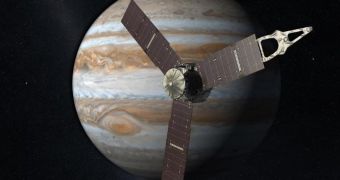When the NASA Juno spacecraft launches this month, it will begin a 5-year trip to Jupiter that will finally enable experts to analyze this largely-unstudied planet. One of the science product the probe will return will by a high-definition (HD) view of the Jovian magnetosphere.
Understanding the way a planet's magnetic protection works is absolutely crucial towards figuring out many of its properties. Even its interactions with the Sun can become clearer once the strength, intensity and shape of the magnetosphere is detected.
Earth too has such a protective device, which shields us against the harmful effects of solar flares and radiation. Mars however does not, since its core has long since solidified. In fact, only the gas giants and some of their moons still retain a working magnetosphere.
After it arrives at Jupiter – and achieves orbital insertion – Juno will carry out about 33 orbits, during which time it will need to collect all the data it was sent there to get. The spacecraft's instrument suite includes two magnetometers, that will play an essential role in creating the HD view.
Jupiter has the most intense magnetic field of any body in the solar system other than the Sun itself. The dynamo movements that generate this field are of great interest to scientists, who are looking forward for the day when Juno will start sending back its first batches of data.
The probe still has to get past the launch and complete a 400-million-mile voyage before this becomes a reality. In addition to the magnetosphere, the orbiter will also study the origins and evolution of Jupiter, its gravity field, internal structure, water and ammonia levels, and its powerful auroras.
The Greenbelt, Maryland-based NASA Goddard Space Flight Center (GSFC) designed and built the twin magnetometers that are installed on Juno. Both instruments measure fields weak and strong alike, and their placement a short distance apart ensures maximum data resolution
“Valuable information about Jupiter’s magnetic field was gathered by the Pioneer 10 and 11 missions in the early 1970s and Voyagers 1 and 2 in the late '70s,” GSFC Juno deputy principal investigator Jack Connerney explains.
“But previous spacecraft orbited among Jupiter's moons; Juno, a polar orbiter, will be the first magnetic mapping mission to Jupiter,” adds the expert, who is also the head of the magnetometer team.
He is collaborating closely with Scott Bolton – the principal investigator of the mission – who is based at the Southwest Research Institute (SwRi), in San Antonio, Texas. “Juno's measurements may be accurate enough to detect slow time variations in Jupiter's magnetic field,” the expert says.
“If Jupiter has these variations, measuring them will let us visualize for the first time how the planet's dynamo works. And that will give us a new understanding of the dynamos of other planets, both here in our solar system and beyond,” Connerney concludes.

 14 DAY TRIAL //
14 DAY TRIAL //